Using Art to Help Heal
Artist Julia Kito Kirtley poured herself into her art as she faced breast cancer treatment. Now, she is sharing the healing power of art with others going on a similar journey.
Julia Kito Kirtley sweeps streaks of red paint across her canvas. “Red reminds me to stay empowered,” says the artist to the patients and staff from NewYork-Presbyterian Brooklyn Methodist Hospital in her Zoom class. “As I draw, I think, ‘This is my road map to wellness.’”
Every few weeks, Kirtley teaches a virtual art therapy class from her home in Brooklyn, where she is surrounded by her art — mixed-media cityscapes and “other abstractions that depict the eclectic and kinetic vibe of New York City,” as she describes them. She plays jazz music as she guides the class through self-portraits, beginning with a circle.
Kirtley, 58, calls herself a “breast cancer warrior,” and has used her art to help her cope with anxiety and heal after receiving a cancer diagnosis and undergoing treatment. While facing cancer, she discovered new purpose in her art and became inspired to share that resource with others. “It’s an escape,” says Kirtley. “There is power in creating new ideas.”
She pauses often through the class to encourage each participant and comment on their work. “That reminds me of light,” Kirtley says to one patient on their use of yellow around their head. Her radiation oncologist, Dr. Onyinye Balogun, who also joined this class, chimes in to say, “I think my head looks too big.” Kirtley disagrees. “I love it,” she says. “Art is a process. Don’t worry about how big, straight, or cooked something is. Try to let go of thoughts.”
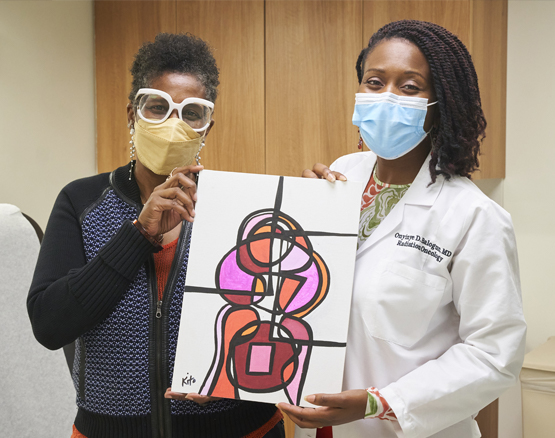
Julia Kito Kirtley with her radiation oncologist, Dr. Onyinye Balogun, and the artwork Dr. Balogun created in Kirtley’s class.
Art as therapy
Kirtley had found solace in her art since she was a child, skipping recess through middle school to stay in the art room to draw or paint. “Art chose me,” says Kirtley. “It was always the thing that calmed me down, and put me in a mode where I could figure things out, breathe, and not be worried about things I had no control over.” She pursued art later in life at Pratt Institute and has been creating and teaching art for 15 years.
When Kirtley was diagnosed with breast cancer at the end of 2021, she says she initially felt “devastated” before turning to her art to face her illness. “I think since my breast cancer diagnosis, I’ve produced more art than ever before,” she says with a laugh. “Some days I wake up and think, ‘How am I feeling?’ There is more to worry about on a breast cancer journey, so I use art to keep myself in a healing mode and get rid of worrisome thoughts.”
Healing With Art
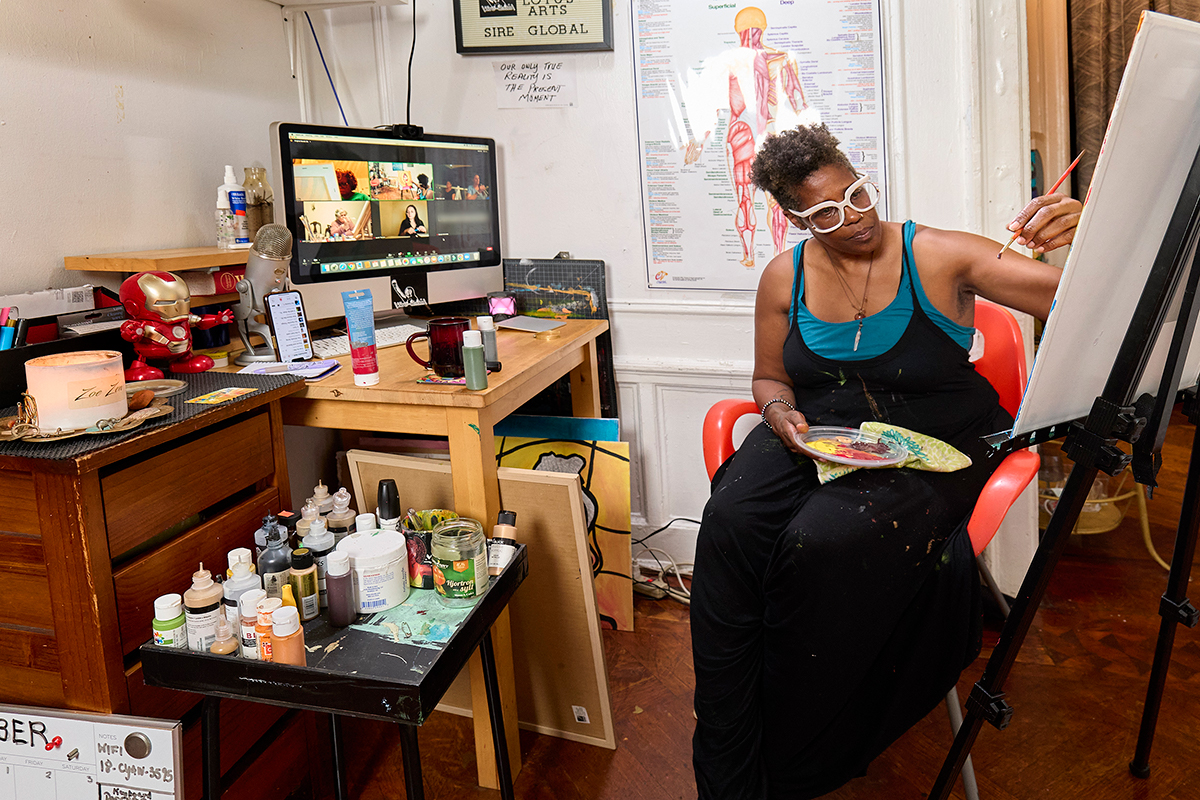
Julia Kito Kirtley teaches an art therapy class to patients at NewYork-Presbyterian Brooklyn Methodist Hospital.
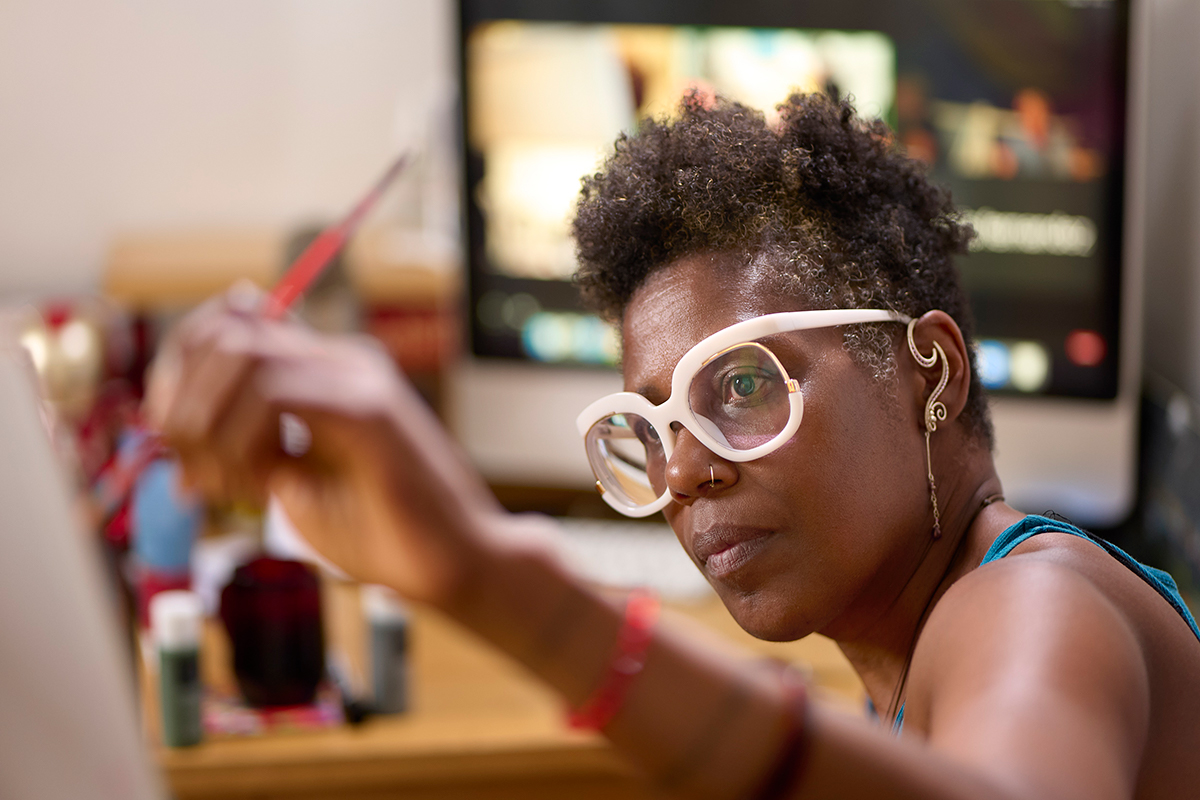
The color red reminds Kirtley to stay empowered.

Kirtley guides the class through a self-portrait.
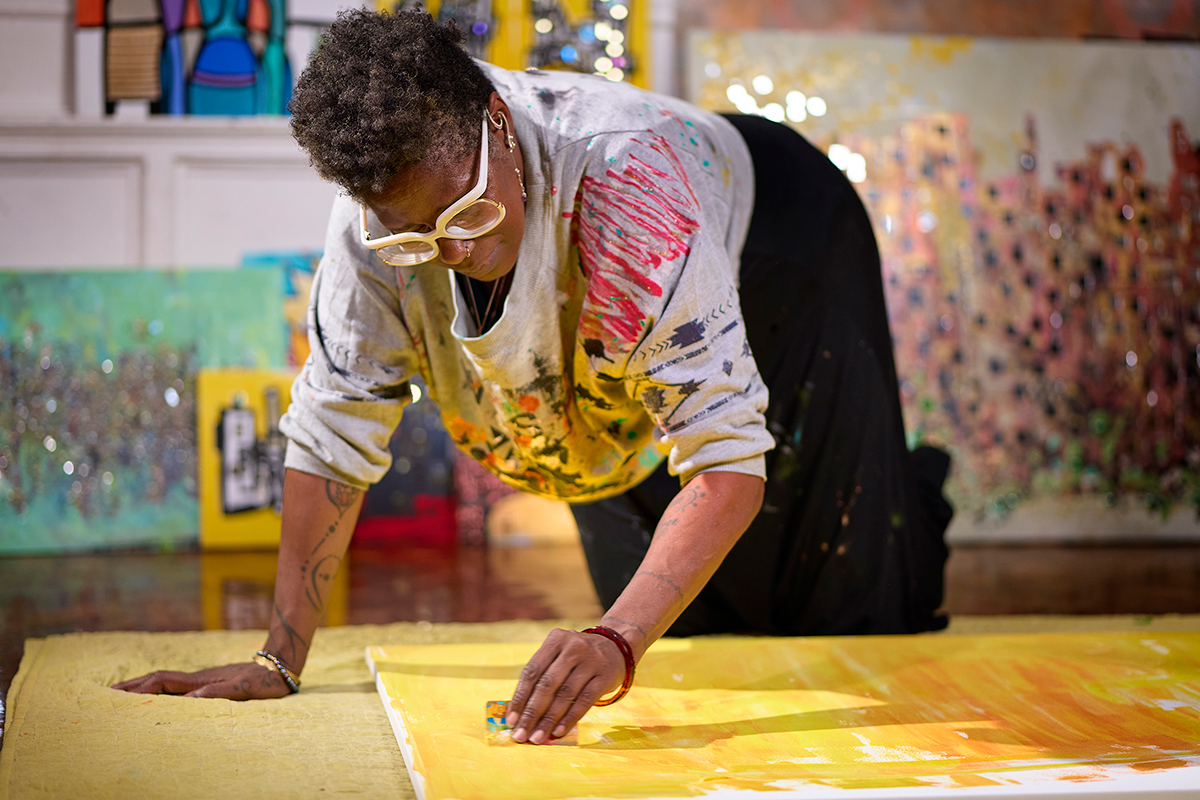
Kirtley at work.

Kirtley’s work consists of mixed-media cityscapes and other abstractions.
Sharing healing with others
Even before her diagnosis, Kirtley was interested in using art as a healing tool, and took a course called “Healing With the Arts” in 2020.
“I thought it could help me with my practice from a spiritual point of view, and help others going through various difficulties,” says Kirtley. She had just begun teaching classes to inclusion groups and crisis centers when a mammogram showed something suspicious, and a biopsy confirmed it was cancer. “I thought, ‘Oh my goodness, I just learned these techniques and specifically how to use art for healing purposes,’” she recalls. “I’m so grateful for that.”
Kirtley took her art journal with her everywhere she went to draw and calm her nerves. “Whenever I was feeling sad, frustrated, or angry, I wanted to stop feeling sorry for myself and just use art as that healing tool to generate happiness, curiosity, and creativity,” she says.
A friend referred Kirtley to NewYork-Presbyterian Brooklyn Methodist Hospital, and Kirtley says she instantly liked her care team, which included Dr. Balogun, who is also an assistant professor of clinical radiation oncology at Weill Cornell Medicine; Dr. Vivian Bea, section chief of breast surgical oncology and director of the breast program; and Dr. Evelyn Taiwo, medical oncologist (Drs. Bea and Taiwo are also on the faculty of Weill Cornell Medicine). “I felt listened to,” she says.
Kirtley was drawing in her journal while waiting for a follow-up appointment with Dr. Balogun over the summer when she noticed the walls by Dr. Balogun’s office were bare. “I thought, ‘Wouldn’t it be nice if there was some artwork?’” She started to picture the work of other patients decorating the wall and got the idea to lead a class for patients. “I liked the idea of a small art gallery to encourage people,” she says. “I felt like we could all use something that would help us — not enjoy the process, but bear it. We can still use creativity and build and make beautiful things, even if we’re going through this uncertainty.”
She broached the idea with Dr. Balogun, who had learned during an earlier visit that Kirtley was an artist. “I jumped at the idea,” says Dr. Balogun. “I’m a lover of the arts, and art therapy has been shown to improve people’s quality of life and their willingness to go through treatment. [Kirtley] is extremely talented, and when she offered to do the art therapy classes, it was a no-brainer.”
Dr. Balogun enlisted the help of her department’s administrator, Kaitlyn Shechtman.
“Dr. Balogun popped into my office saying, ‘We have this idea…,’” recalls Shechtman. “If Dr. Balogun is passionate, it’s easy to be passionate; we all feel it. Then she introduced me to Julia, who radiates positive energy.”
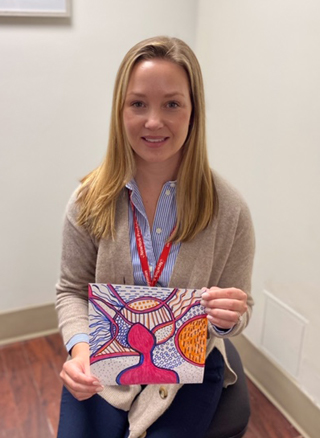
Kaitlyn Shechtman, administrator of radiation oncology at NewYork-Presbyterian Brooklyn Methodist Hospital, with her self-portrait from class.
Shechtman got to work organizing the class and purchased canvases, paint, and paintbrushes for art kits to send to patients who signed up for the class. Julia taught her first class in August.
“The class was phenomenal,” says Dr. Balogun. “Julia is very talented at making people feel comfortable, and she just inspired so much peace. She talked to us about painting ourselves, looking out at the path and seeing all the different possibilities and just taking a very positive approach. The class had a great impact on me, and I can only imagine the effect it had on the individuals who had been diagnosed with cancer.”
“It was a great class, and I loved seeing other patients enjoying the class as much as I did,” says Jennifer Ryan, one of the patients who participated. “Julia was incredible.”
Kirtley plans to teach more classes through NewYork-Presbyterian Brooklyn Methodist Hospital and is interested in traveling around the city to provide more classes and sessions for those who need it. She takes joy in knowing the class has brought peace, creativity, and inspiration to others. “We’re all just finding our way,” she says. “I’m not there to teach them to do what I’m doing; I just want them to open up so that they can discover what they can do. In that discovery, there is healing.”
Learn more about breast care at NewYork-Presbyterian Brooklyn Methodist Hospital.

